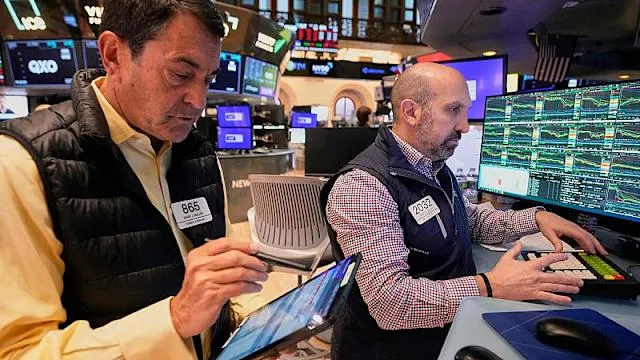In the early hours of Monday, April 7, 2025, financial markets witnessed one of the most turbulent sessions in recent memory. Major indices like the S&P 500, the Dow Jones Industrial Average, and even global benchmarks were buffeted by wild swings as trade tensions and tariff escalations sent shockwaves through investor sentiment. The US economy, already grappling with uncertainty, faced renewed pressure as President Donald Trump doubled down on a policy of aggressive tariffs—promising both permanency and negotiation on different tariffs—while warning China of even harsher measures. In this extended report, we delve into the unfolding drama on Wall Street, examine the potential global economic repercussions, and explore what these events mean for investors, businesses, and the global trading system.
Unprecedented Volatility in US Markets
A Day of Extreme Swings
After a rollercoaster of trading triggered by Trump’s latest tariff announcements, US shares exhibited a high degree of volatility throughout the day. The S&P 500—the benchmark tracking 500 of the country’s largest companies—closed nearly flat at a loss of roughly 0.2%. That modest end-of-day change belied the drastic intraday gyrations, with shares experiencing swings reminiscent of the turbulent days during the early stage of the COVID-19 pandemic.
Howard Silverblatt, a veteran index analyst at S&P Dow Jones Indices, noted, “I have seen few comparable swings in a career spanning four decades on Wall Street. The sheer level of uncertainty is driving these dramatic fluctuations.” His comment highlights the magnitude of investor anxiety, as uncertainty and mixed signals from the highest levels of government have fueled rapid reversals in market sentiment.
Mixed Signals from the Top
President Trump’s recent remarks have been a study in contradiction. On one hand, he escalated his tariff threats against China—threatening to impose an additional 50% tariff on Chinese imports unless Beijing rolled back its retaliatory measures. On the other hand, he hinted at the possibility of negotiating some tariffs, stating, “They can both be true.” This ambiguous message left markets reeling as they attempted to decipher whether the escalation was a permanent shift in US trade policy or a temporary tactic aimed at extracting concessions from trading partners.
Treasury Secretary Scott Bessent reinforced this narrative by indicating that discussions had begun with Japan and that more talks with other nations were on the horizon. Moreover, the White House claimed that over 50 countries had reached out to discuss trade, suggesting the potential for broader international negotiations. Yet, for investors, these encouraging reports were quickly overshadowed by the immediate reality of sharp price drops and uncertainty over future corporate profits.
Trade Tensions and Global Implications
Escalation into a Trade War?
One of the gravest concerns for investors and policymakers alike is the prospect of a full-scale trade war. Recent tariff increases—and the possibility of further hikes—have already taken a toll on market confidence. In the days following the tariff announcement, stock markets in both the United States and the United Kingdom experienced some of the worst one-day falls since the advent of COVID-19 in 2020. With more than 10% of the S&P 500’s value wiped out over three consecutive days, the index now trades at levels reminiscent of a year ago—a sobering reminder of the disruptions that persistent trade tensions can cause.
The situation is compounded by China’s own retaliatory measures, notably the 34% tariff imposed on US goods. Analysts warn that if the tit-for-tat escalates, the cascading effect could lead to a global economic slowdown. Russ Mould, investment director at AJ Bell, encapsulated this worry when he said, “Fundamentally, investors are anxious about a big hit to corporate profits and a massive slowdown in economic growth.” Such statements echo fears first popularized during previous trade conflicts, indicating that the stakes have never been higher.
International Diplomatic Efforts
The international response has been a mix of cautious optimism and stark warning. European Union trade official Maroš Šefčovič remarked, “I believe that sooner or later, we will be at the negotiating table,” signaling that the EU is preparing to engage in talks about how to mitigate the fallout. European markets have not been insulated either; London’s FTSE 100, for instance, plunged 4.4% to its lowest level in over a year, and key indices in Paris and Berlin also closed lower.
Across the Pacific, Asian markets have been hit hard. Early trading in Asia saw some of the leading indexes tumble in what one analyst described as a “bloodbath.” The ripple effect of US tariffs coupled with retaliatory moves from China has placed emerging markets under enormous strain. Japan, whose economy is heavily export-driven, is monitoring the situation closely, with officials signaling readiness for trade talks. This environment of heightened diplomatic activity demonstrates that trade policy decisions in Washington are no longer a matter confined to US borders but are reshaping economic relationships across continents.
Investor Reactions: Between Caution and Opportunity
The Hunt for Safe Havens
As markets oscillated wildly, investors sought refuge in what are traditionally seen as “safe-haven” assets. Gold, long the refuge for uncertainty, saw its price drop momentarily—a sign that even the safe havens were not immune to the turbulence. Likewise, copper, an economic bellwether widely used in industrial applications, slid roughly 3%. This correlated decline in commodities, typically indicative of slowed industrial activity and economic contraction, has added another layer of apprehension among investors.
The crisis of confidence is perhaps best illustrated by the brief yet dramatic fall of the S&P 500. In early trading, the index briefly dropped more than 20% from its February peak—a level that, if sustained, would have signaled the onset of a bear market. However, a rumour that the White House might consider temporarily putting tariffs on hold triggered a swift rebound, with shares surging more than 7% in just minutes. This stark reversal underscores the extent to which investor sentiment can pivot on even the slightest hint of policy change.
Commentary from Business Leaders
High-profile figures in the financial world have not remained silent. Jamie Dimon, CEO of JPMorgan Chase, along with influential investors like Bill Ackman and Daniel Loeb, have publicly expressed their disquiet over the escalating trade tensions. Dimon, in particular, warned that the prolonged tariff impasse could disrupt corporate strategies and undermine earnings—a concern that is quickly reflected in market fundamentals. In an environment where uncertainty reigns, even the most stalwart institutions find themselves grappling with the unpredictability of policy decisions.
Mike Mussio, President of FBB Capital, summed it up by calling the scenario “an unforced error in terms of policy.” His critique resonates with many investors who feel caught between the contradictory signals being emitted by the administration and the harsh realities of global markets.
Impact on the Broader Economy
Corporate Profits and Economic Growth
The cascading impact of tariffs extends far beyond stock market indices. Corporate earnings, long a barometer of economic health, are expected to take a significant hit as companies absorb the higher costs associated with increased tariffs. Rising production costs can lead to reduced profit margins and, in many cases, trigger price hikes for consumers. Such a chain reaction is concerning because it has the potential to slow down economic growth at a critical juncture when many economies are still in recovery mode.
The potential for a recession looms large, with some experts citing early warning signs that should not be ignored. A combination of aggressive tariff policies and the risk of retaliatory measures could trigger a broader slowdown that mirrors past economic downturns. Recent developments have even prompted comparisons with the pre-recession conditions seen during the 2008 financial crisis and the market corrections that followed the onset of the COVID-19 pandemic in 2020.
Consumer Confidence and Spending
Trade tensions do not only affect corporate earnings—they also have a profound impact on consumer confidence. When prices rise due to tariffs, consumers tend to cut back on spending, which can lead to a cyclical slowdown in economic activity. As households absorb higher costs in everyday goods, there is less discretionary income available for other expenditures. This effect is particularly pronounced in the United States, where consumer spending drives a significant portion of the economy.
In addition, the psychological impact of prolonged uncertainty cannot be understated. As news of market volatility and economic uncertainty spreads, consumer sentiment may take a hit, further exacerbating an economic slowdown. In an environment where every percentage point drop in consumer confidence can lead to measurable declines in spending, the combined effect of tariffs and retaliatory measures could prove to be a double blow to the economy.
Global Commodity Markets React
Oil, Copper, and Gold Under Pressure
Among the commodities, oil has been particularly sensitive to the new trade dynamics. Initially, oil prices plummeted by more than 4% as traders anticipated decreased global demand in a scenario of economic slowdown. Although prices managed to recover some ground later in the day, the initial drop sent a clear signal about the fragility of commodity markets in the face of geopolitical and trade uncertainties.
Copper, too, has recorded declines that signal broader economic concerns. Widely regarded as a “barometer” for global industrial activity, copper’s roughly 3% drop suggests that investors are bracing for a slowdown in production and industrial output—a key driver of economic growth. Meanwhile, gold, typically the go-to asset in times of turmoil, did not see the usual surge, highlighting the pervasive uncertainty that characterizes the current market environment.
The simultaneous downturn in these commodities underscores the broader implications of the tariff escalation. As the cost of production increases, industries ranging from technology to automotive manufacturing face the dual pressure of rising raw material costs and reduced consumer demand. The convergence of these factors suggests that the impact of the trade dispute may ripple through various sectors of the global economy, creating long-lasting structural changes.
Looking Ahead: The Future of Trade and Market Stability
Negotiations and Potential Policy Shifts
Despite the chaos, there remains a glimmer of hope that diplomatic negotiations could defuse the current tensions. The fact that more than 50 countries have expressed willingness to engage in talks with the White House suggests that there might be room for compromise. European and Asian counterparts, as well as traditional US allies, are closely watching every move. If the rumored pause on tariffs materializes, even temporarily, it could provide the breathing room needed for constructive dialogue.
In recent weeks, there have been indications that behind closed doors, conversations are already underway to chart a path forward. Analysts believe that if President Trump can steer these negotiations towards a more balanced trade policy—one that balances protectionist measures with international cooperation—the worst effects of the current market turbulence could be mitigated. However, the challenge remains formidable: reconciling domestic political pressures with the exigencies of a globalized economy is no small feat.
The Broader Implications for the Global Economy
The current episode is a stark reminder of the interconnected nature of today’s global economy. Policy decisions in Washington resonate in London, Beijing, Tokyo, and beyond. For many emerging economies, already grappling with low growth and limited fiscal space, the uncertainty triggered by US tariff policy could have profound effects on their development trajectories. Analysts warn that if the trade dispute continues unchecked, it could pave the way for a prolonged period of economic stagnation or even recession in vulnerable regions.
Moreover, the technological and financial landscapes are also evolving. As companies increasingly rely on global supply chains, disruptions in trade can lead to bottlenecks in production and distribution. In addition, the migration towards digital finance and the growing importance of data-driven decision-making mean that even sectors not directly linked to physical goods are feeling the impact of trade uncertainties.
Conclusion: Navigating a Period of Uncertainty
The wild market swings witnessed on Monday are more than a blip on the trading screen—they are symptomatic of a deeper, systemic uncertainty that now pervades the global economy. With President Trump’s tariff policies at the center of the debate, the world finds itself at a crossroads where hardline protectionism meets the realities of a highly interconnected global market.
For investors, the imperative is clear: vigilance and adaptability are key. The dramatic intraday swings on Wall Street remind us that market sentiment can be fragile and that investor decisions today may have far-reaching consequences tomorrow. For policymakers and business leaders, the challenge is equally daunting—to find a pathway that secures domestic interests without triggering a cascading trade war that could doom global growth.
While much depends on the outcome of forthcoming negotiations and potential policy adjustments, one thing remains certain: the stakes are incredibly high. Corporate profits, consumer confidence, and the stability of entire economies hang in the balance. In these turbulent times, it is not merely a question of short-term gains or losses but of shaping a future where trade and diplomacy serve as the foundation for sustainable, inclusive growth.
As the saga of tariffs and trade unfolds, market participants around the world will be watching closely, weighing every statement, every policy hint, and every fluctuation in price. The coming weeks and months will be critical in determining whether the current market volatility marks the beginning of a long recessionary phase or whether it can be steered back towards a path of recovery and renewed investor confidence.
In a world where uncertainty is the only constant, the story of Monday’s trading session is a powerful reminder that even in the face of wild market swings, there is room for hope, negotiation, and ultimately, the possibility of a more stable economic future. With international cooperation and sound policy decisions, the current storm may well pass, giving way to a more balanced global economy that benefits all.
Ready to take your career to the next level? Join our dynamic courses: ACCA, HESI A2, ATI TEAS 7 , HESI EXIT , NCLEX – RN and NCLEX – PN, Financial Literacy!🌟 Dive into a world of opportunities and empower yourself for success. Explore more at Serrari Ed and start your exciting journey today! ✨
photo source: Google
By: Montel Kamau
Serrari Financial Analyst
8th April, 2025
Article, Financial and News Disclaimer
The Value of a Financial Advisor
While this article offers valuable insights, it is essential to recognize that personal finance can be highly complex and unique to each individual. A financial advisor provides professional expertise and personalized guidance to help you make well-informed decisions tailored to your specific circumstances and goals.
Beyond offering knowledge, a financial advisor serves as a trusted partner to help you stay disciplined, avoid common pitfalls, and remain focused on your long-term objectives. Their perspective and experience can complement your own efforts, enhancing your financial well-being and ensuring a more confident approach to managing your finances.
Disclaimer: This article is for informational purposes only and does not constitute financial advice. Readers are encouraged to consult a licensed financial advisor to obtain guidance specific to their financial situation.
Article and News Disclaimer
The information provided on www.serrarigroup.com is for general informational purposes only. While we strive to keep the information up to date and accurate, we make no representations or warranties of any kind, express or implied, about the completeness, accuracy, reliability, suitability, or availability with respect to the website or the information, products, services, or related graphics contained on the website for any purpose. Any reliance you place on such information is therefore strictly at your own risk.
www.serrarigroup.com is not responsible for any errors or omissions, or for the results obtained from the use of this information. All information on the website is provided on an as-is basis, with no guarantee of completeness, accuracy, timeliness, or of the results obtained from the use of this information, and without warranty of any kind, express or implied, including but not limited to warranties of performance, merchantability, and fitness for a particular purpose.
In no event will www.serrarigroup.com be liable to you or anyone else for any decision made or action taken in reliance on the information provided on the website or for any consequential, special, or similar damages, even if advised of the possibility of such damages.
The articles, news, and information presented on www.serrarigroup.com reflect the opinions of the respective authors and contributors and do not necessarily represent the views of the website or its management. Any views or opinions expressed are solely those of the individual authors and do not represent the website's views or opinions as a whole.
The content on www.serrarigroup.com may include links to external websites, which are provided for convenience and informational purposes only. We have no control over the nature, content, and availability of those sites. The inclusion of any links does not necessarily imply a recommendation or endorsement of the views expressed within them.
Every effort is made to keep the website up and running smoothly. However, www.serrarigroup.com takes no responsibility for, and will not be liable for, the website being temporarily unavailable due to technical issues beyond our control.
Please note that laws, regulations, and information can change rapidly, and we advise you to conduct further research and seek professional advice when necessary.
By using www.serrarigroup.com, you agree to this disclaimer and its terms. If you do not agree with this disclaimer, please do not use the website.
www.serrarigroup.com, reserves the right to update, modify, or remove any part of this disclaimer without prior notice. It is your responsibility to review this disclaimer periodically for changes.
Serrari Group 2025





